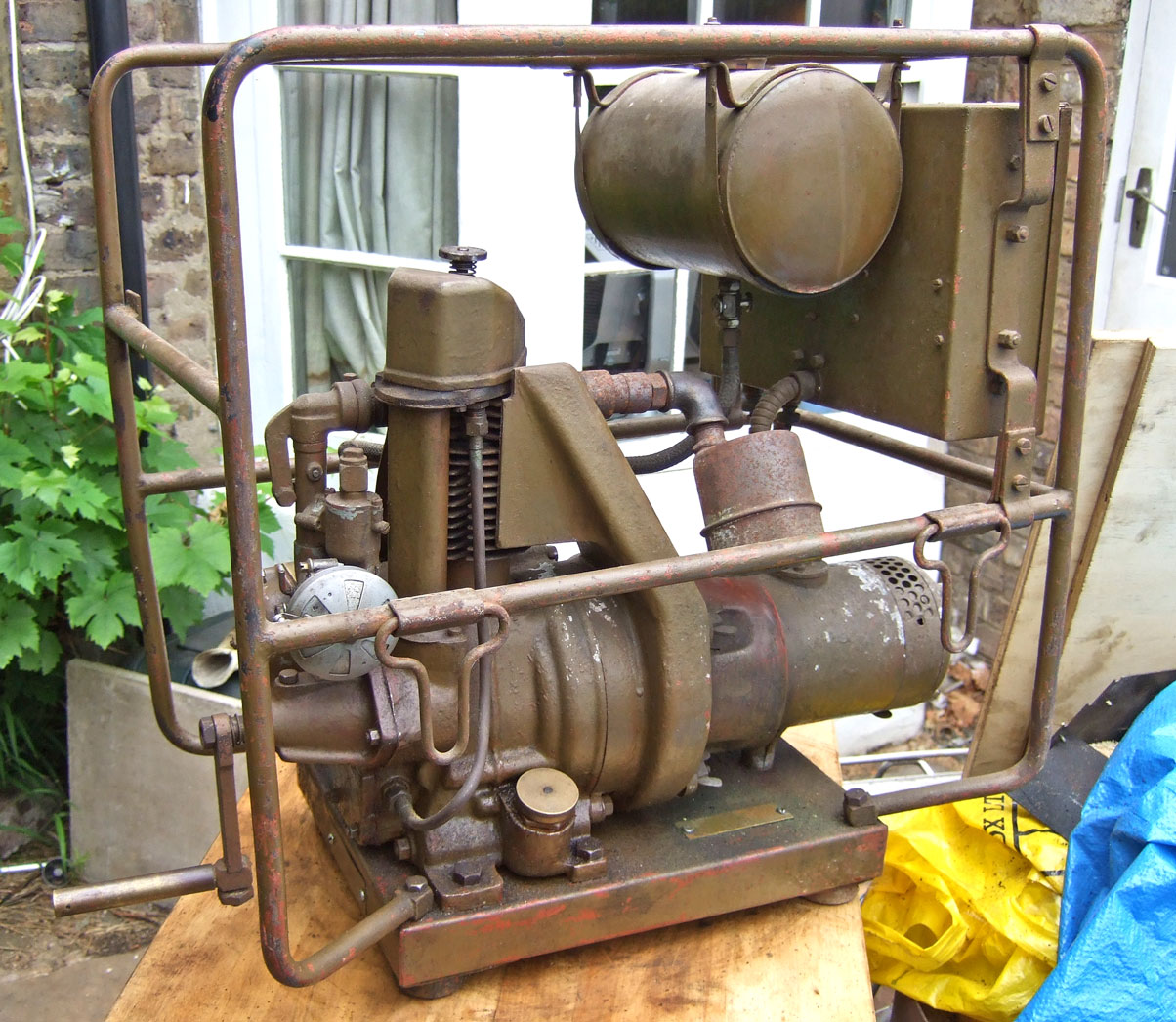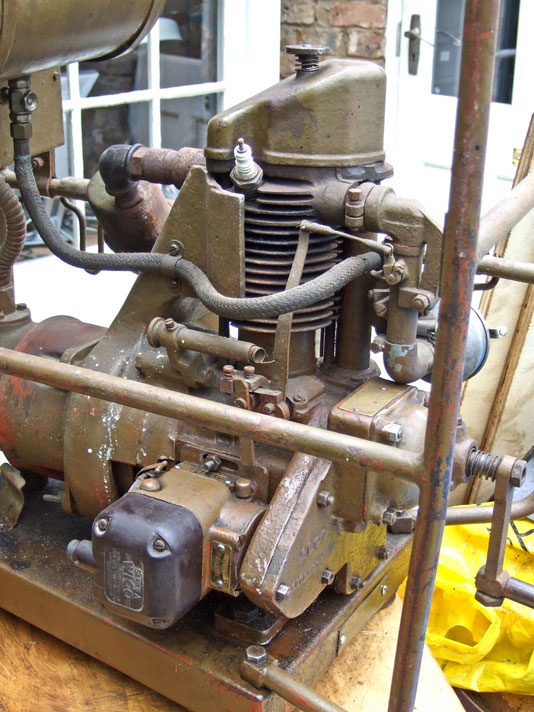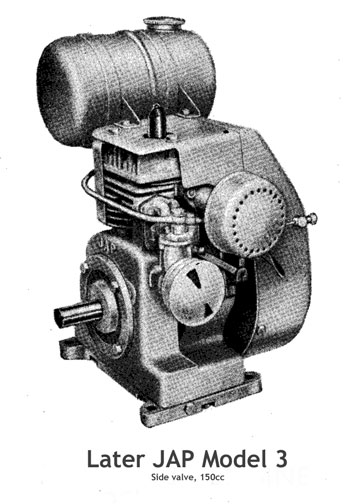Alco Featherweight stationary engine (aka JAP Model 3)
|
The two 129cc, OHV engines shown below are branded 'ALCO' and were marketed by Arthur Lyon & Co. (hence ALCO) during the second world war. They were coupled with various items of equipment as power units for use by British forces - principally battery chargers and fuel pumps. The Alco Featherweight was manufactured for Arthur Lyon by JAP (J.A.Prestwich) and was simply a rebranded JAP Model 3, with all parts interchangeable.
The first engine on the left is an ex-generator power unit and that on the right was fitted with a flat belt pulley as original equipment - probably mounted with a pump alongside as part of a mobile refueling rig on an RAF base. Both engines have all-alloy cases and cowls and both have patches of khaki paint present as clues to their original owners.


The Featherweight generator
I estimate 50%-60% of these engines were originally sold as part of an 'Alco Featherweight Portable Battery Charging Set' and the rest were sold as free standing engines or partnered with fuel pumps and similar ground equipment. Ex-charger engines show evidence of four studs fitted in the rear cowl to which the charger's dynamo flange was bolted with butterfly nuts. Non-charger engines have a plain rear cowl surface with no studs or holes. So if you possess a charger frame and equipment that's missing an engine and you're on the lookout for one, be sure to check for the presence of mounting studs in the cowl before any money changes hands.


The JAP Model 3 and the war
The JAP Model 3 was clearly a wartime concept, designed down to a very simple spec and budget, using light alloy wherever possible for low weight and portability, but also capable of being manufactured from whatever metal was available at different times during the war. Hence you will find these JAP/Alcos with a wide variety of cast iron and alloy parts, depending on the period of manufacture. In wartime Air Ministry documents, the Alco Featherweight engine is referred to as a 'J.A.P. engine, Type ALCO'. Notice also the captive, folding starting handle - so it won't get lost when the unit is moved around a site or thrown in the back of a truck.


A choice of magnetos
It seems likely that the JAP Model 3 was originally designed to be mated with a BTH magneto - hence the oddly shaped cast-in hole in the side of the cowl/crankcase. This hole provides the necessary clearance for a BTH mag's longer body (see picture above). Despite that, the vast majority of these engines actually left the factory with the more compact Wico mag - hence the characteristic gaping hole at the rear. Perhaps BTH were engaged on more pressing war work and couldn't supply their mags in sufficient numbers.
|


Spares required
Neither of my Alco engines are runners at the moment so the intention is to build one out of two, or to rebuild the pair of them if enough parts are serviceable or can be found. If you happen to have any Model 3 or Alco Featherweight parts you could sell or pass on or even a complete engine, please get in touch (see foot of page). I'm currently looking for a cylinder head, pushrod tunnel tube, oil breather pipe, suitable magneto/coils/parts and an alloy flat-belt pulley (mine has a busted flange) among other items.
|


A neat, simple design
They are very robust little engines - the scale of the plug cap or the electric socket in the background of the first shot gives a good idea of just how 'little' they are - standing about 16 inches high. They are straightforward to work on too. They live up to their 'Featherweight' name, being easy for one person to carry around. And as they're a single cylinder, single-cam design with a very basic carb, they're easy to time and set up (when you know how). A very nice simple design, in fact, and ideal as a first rebuild project.
They look distinctive too, in a long-stroke period OHV kind of way - it wouldn't be hard to imagine one of these tucked into a 1930s vintage 125/150cc motorcycle frame. In fact they look rather like a big JAP bike engine that's been shrunk down, or built as a half-size scale model. They certainly show their road-engine heritage in a way that no other JAP stationary engine does. I believe the Model 3 was the only OHV industrial engine JAP ever produced - everything else was side-valve or 2-stroke - so it's quite unique in that sense.
|


Facts and figures
These engines were around for such a short space of time (just 10-12 years) that there isn't much information available on them for restorers or rebuilders. I'll add any info I can find to this page as things progress, so hopefully it should become a useful resource for other owners. Note that this version of the JAP OHV Model 3 was replaced by a totally different 150cc side-valve Model 3 soon after the end of the war (see below), which can cause confusion when the engine is being discussed or spare parts searched for.
It's hard to say how many early-type Alco/JAP model 3 engines were made all told, but it's likely to be in excess of 20,000, so they're certainly not a rare engine (if anything, the later side-valve Model 3 is the rare one). I've seen Alco versions with serial numbers ranging from 600 to above 10,000 and by the time you add in JAP's own Model 3 output, 20,000 may be on the conservative side. They also went all over the world with the various forces and can therefore turn up anywhere. Fastenings are an odd mixture of Whitworth/BSF and AF - perhaps a consequence of multiple standards after the Americans came into the war.
|
Main features of the engine and charging set:
- Engine: Lyon "Alco Featherweight", Type F (a rebranded JAP Model 3)
- 129cc, single cylinder, 51mm bore, 62.5mm stroke
- 4-stroke, governed, single cam, OHV
- Develops 1.25hp at 3000rpm
- Ignition advance 23 degrees
- Contact breaker gap 0.012"
- Original spark plug Lodge S.R.14, 14mm, 3-point
- Spark plug gap 0.018"
- Tappet clearance 0.002"
- WICO A865Z or BTH (MC1-AP4 L.H.) magnetos were fitted by the factory at various times
- Shunt wound DC generator, output 360W, 18 Amps, 20volts
- Complete charging set weighs 105lbs (47.6kg) with all standard equipment
- Manufactured from around 1937 to around 1948
|

|
JAP/ALCO related links:
A nicely restored JAP Model 3 engine running (YouTube)
Restored ALCO Featherweight engine running on the bench (YouTube)
JAP Model 3 being started and run (YouTube)
ALCO Featherweight generator set running (YouTube)
JAP Model 3 rebuild, introduction ('Steamwally' - YouTube)
JAP Model 3 rebuild, part 1 ('Steamwally' - YouTube)
JAP Model 3 rebuild, part 2 ('Steamwally' - YouTube)
The later side-valve JAP Model 3, for reference (YouTube)
Long running Jap Model 3 rebuild thread on the Stationary Engine Forum ('Nutgone')
Vast Photobucket collection of JAP Model 3 stripdown and rebuild pics ('Nutgone')
Back to home page
© neil f, 2003-2018, (web dot master at riscy dot uk)
|
|
|
|